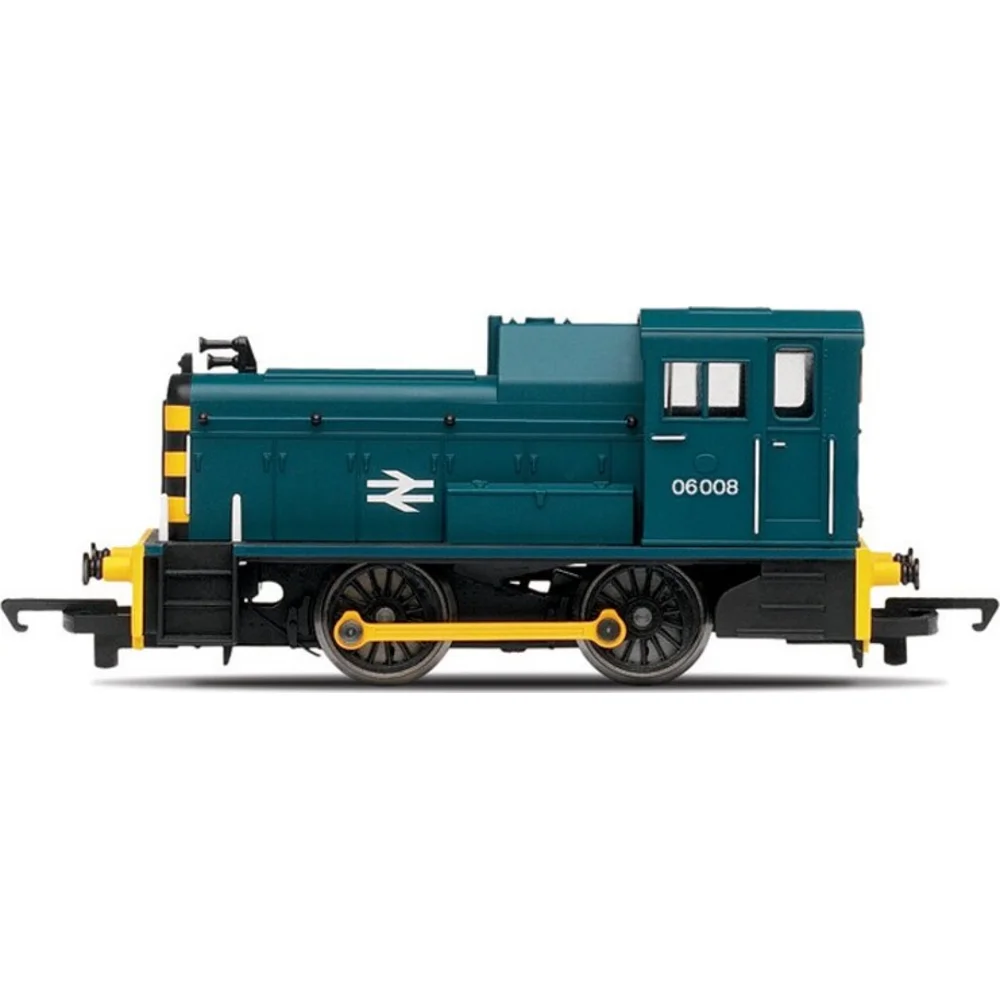Hornby R3065
British Rail Class 06 06008 British Rail Blue
Tooling
Hornby introduced its British Rail Class 06 model in 1988, representing the small 0-4-0 diesel-mechanical shunters built by Andrew Barclay between 1958 and 1960 for the Scottish Region of British Railways. These locomotives were primarily used for yard shunting and short-haul duties. The Hornby tooling was aimed at providing an affordable, entry-level model for OO gauge layouts, and it remained in production for many years across various ranges, including the Railroad series.
Tooling Features
- Construction: Pre-assembled plastic bodyshell with factory-fitted details; lightweight chassis
- Detailing: Separate handrails, bufferbeam detail (detailing pack), cab glazing, basic footplate and interior detail
- Couplings: Standard Hornby tension-lock couplers, fixed mountings
Mechanical & Electrical
- Drive: 0-4-0 configuration, 2 driven axles
- Pickups: All wheels, 2-rail DC
- Weighting: Incorporated within chassis
- Lighting: None
- Performance: High top speed, limited slow-speed control
DCC Capability
DCC compatible but no factory socket; conversion requires hard-wiring. No sound provision.
Liveries Produced
BR Green (late crest), BR Blue, Departmental Grey, Civil Engineers ‘Dutch’, Virgin Trains, Private Owner schemes, and special editions such as Pullman and Robert Horne Paper Co.
Reviews & Commentary
Praised for affordability and suitability for beginners. Criticised for limited detailing, unrealistic speed, and light weight. Later Railroad versions improved slightly but remain basic compared to modern standards.
Interesting Notes
The tooling appeared in starter sets and budget ranges for decades. Popular for kitbashing. Prototype 06003 is preserved at the Museum of Science & Industry in Manchester.
Class & Prototype
- Class: British Rail Class 06
- Traction: Diesel
- Transmission: Mechanical
- Built: 1958-1960
- Total Built: 35
- Running Number: 06008
- Name: -
- Ordered By: British Railways
- Built By: Andrew Barclay Sons & Company
- Built At: Kilmarnock
- Built: 05/1960
- Withdrawn: 10/1980
- Length of Service: 20.4 years
- Running Numbers: BR D2437, BR 06008
- Names: -
Operator & Livery
- Operator: British Rail
- Livery: Blue
British Rail (1965-1997) transformed Britain's railways through revolutionary modernisation, introducing the iconic double arrow logo, Rail Blue livery, and business sectorisation. BR pioneered high-speed rail with the InterCity 125 and Advanced Passenger Train, electrified major routes, and created profitable divisions like InterCity and Network SouthEast. From steam succession through diesel and electric development to privatisation preparation, British Rail's diverse locomotive fleet, multiple livery schemes, and operational scenarios provide unparalleled variety for railway modellers across all scales and periods.
BR Blue, also known as Rail Blue or Monastral Blue, was introduced in 1965 as part of British Rail's comprehensive corporate identity overhaul that accompanied the rebranding from British Railways to British Rail. The colour was officially defined by British Standards BR28/6001 (airless spray finish) and BR28/5321 (brush finish), representing a dark, greyish blue tone specifically chosen to hide dirt and weathering effects well.
The livery was prototyped on the experimental XP64 train in 1964 before becoming the standard scheme from 1 January 1965. Rail Blue was applied to all diesel and electric locomotives with yellow warning panels (initially small, then extending to full yellow ends from 1966). The standardised application included the iconic double arrow logo and Rail Alphabet typeface, creating one of the most successful transport corporate identities of the 20th century.
The livery dominated British Rail operations for over two decades until sectorisation in the 1980s began fragmenting the unified appearance. Despite initial colour fading problems in early applications, these were resolved by the late 1970s when the Large Logo variant was introduced featuring extended yellow areas and full-height double arrow symbols. Rail Blue's enduring appeal among railway enthusiasts reflects its role as the definitive British Rail image during the organisation's most unified period.
